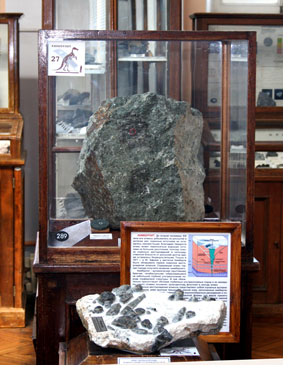 Until the second half of the XIX century, all diamonds were mined from placers in river valleys; their bedrock sources remained unknown. Due to its hardness, diamond can be carried by water streams over long distances, so the search for primary deposits in the immediate vicinity of the placers remained unsuccessful for a long time. Only in 1871 in South Africa, near the town of Kimberley, the first primary diamond deposit was discovered. The rock containing diamond is called “kimberlite”.
Until the second half of the XIX century, all diamonds were mined from placers in river valleys; their bedrock sources remained unknown. Due to its hardness, diamond can be carried by water streams over long distances, so the search for primary deposits in the immediate vicinity of the placers remained unsuccessful for a long time. Only in 1871 in South Africa, near the town of Kimberley, the first primary diamond deposit was discovered. The rock containing diamond is called “kimberlite”.
Kimberlite is a volcanic (eruptive) breccia, hypabyssal (formed at a shallow depth) ultramafic rock of a porphyritic texture. It necessarily contains fragments of deep ultramafic rocks and their minerals: pyrope, olivine, ilmenite, chromium diopside, phlogopite, and sometimes diamond. Primary diamond deposits are huge volcanic vents, less often large fractures in the earth's crust filled with kimberlite. In the upper part, vents usually have funnel-shaped extensions and gradually narrow downwards. Because of their tubular shape, these vents are commonly referred to as volcanic pipes or diatremes. Their diameter at the level of the earth's surface varies from 10-20 to 1500 m. With depth, the pipes gradually narrow and turn into fractures to a few tens of metres wide.
Diamonds are found in kimberlite in the form of separate crystals and their intergrowths, as well as dense or spongy aggregates consisting of many tiny grains. The average mass of diamonds in various deposits ranges from hundredths to one carat. The concentration of diamonds even in the most enriched kimberlite varieties is about one millionth of the mass of the rock.